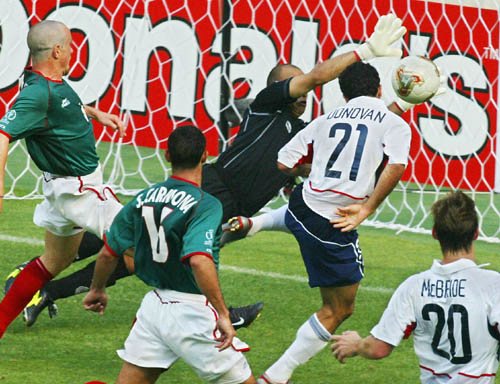An Overview of American Soccer History

The College Era, and Rules Consolidation, 1862-1875
The Working-Class and Immigrant Eras, 1875-1894
The First Dynasties, 1913-1921
The 1960's: The Birth of the American Soccer Renaissance
Outdoor soccer reaches a low: 1985
The Rebirth of Outdoor Soccer, 1988-1994
1994: The World Cup comes to America
From World Cup to Major League Soccer (1995-1996)

The Working-Class and Immigrant Eras, 1875-1894
After the demise of college soccer, the game lay primarily in the hands of working-class communities, who were rapidly adopting the game, as the upper classes increasingly looked to rugby/gridiron. This was a trend in Europe as well as the US. As immigration increased, the new arrivals brought soccer traditions with them, and the game grew rapidly in the Northeastern industrial cities. The growth first took place in the West Hudson region of New Jersey, Philadelphia and New York City, soon spreading by the late 1870's to Fall River, and New Bedford, MA. Pick-up games and loose informal teams soon grew into established clubs and led to corporate sponsorship finally the development of local and even regional leagues. The game spread to other parts of New England including Boston and Rhode Island, and into Baltimore, and in the 1880's, into Chicago, Cleveland and St. Louis, and finally Pittsburgh. The game was continually hampered by sociological forces-- Baseball was seen as the American past-time, and many immigrants would attempt to Americanize themselves to assimilate, often switching to baseball from soccer which was seen increasingly as a sport only played by foreigners.
In 1884, a group of ex-British enthusiasts met in Newark and formed the American Football Association, the fourth national association to be formed. Besides attempting to coordinate the proliferating local and regional amateur leagues, the AFA established the first National Championship competition, the American Cup, which was first won by ONT ("Our New Thread", brand name for the sponsoring sewing manufacturer in Kearny, NJ) in 1885. Before the cup's suspension in 1898, the bulk of the champions were primarily from Southeastern New England, which had turned into the first true soccer hotbed in the country, with its "golden triangle" of Fall River, Pawtucket and New Bedford. The AFA also organized the first national team, which played two games against Canada (a 0-1 loss on 11/28/1885, and a 3-2 win in 1886).
Soccer grew at a moderate pace during the early 1890's, spreading to Denver, Cincinnati, Cleveland and even San Francisco and Los Angeles by the end of the century. Corporate sponsorship had led to some leagues attaining semi-pro stats, and more and more teams were based on cultural and ethnic organizations rather than factories and corporations. The AFA favored the semi-pro clubs in its American Cup scheduling, and the New York clubs withdrew in protest to form the American Amateur Football Association in 1893. The game was slowly being reintroduced on a low-level basis in colleges. Finally, in 1894, the first attempt was made to establish a fully professional soccer league. Interestingly, this league was not promoted by any of the existing soccer associations, but was formed by a group of professional baseball owners from the National league, and was intended to fill the baseball stadiums during down time. The league even used The American League of Professional Football had six teams from major Northeastern cities, and made its 1894 debut with much fanfare, but attendance was low after the first week, partially to the scheduling of too many weekday games, and some managers used less than ethical measures to procure overseas players. The league collapsed among heavy financial losses during its first season.